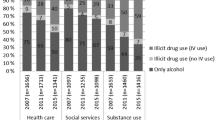Abstract
A large number of adults with substance use disorder (SUD) do not receive treatment for their condition. Using data from the 2008–2013 National Survey of Drug Use and Health (NSDUH), this study analyzes why individuals with SUD report not receiving treatment even when they perceived a need for it. It further examines the variations in reported reasons for not receiving treatment by health insurance status and type. The results suggest that barriers such as stigma, lack of readiness to stop using substances, and not making treatment a priority are more common among the insured population, especially among those with private insurance. Financial barriers, such as not being able to afford the cost of treatment, are more prominent among the uninsured population. Efforts to improve utilization of treatment services will need to address financial as well as barriers related to stigma.
Similar content being viewed by others
References
Substance Abuse and Mental Health Services Administration. Use of behavioral health services is expected to increase under the Affordable Care Act. Rockville: Center for Behavioral Health Statistics & Quality, 2014.
Ali MM, Teich J, Woodward A, et al. The implications of the Affordable Care Act for behavioral health services utilization. Administration and Policy in Mental Health and Mental Health Services Research. 2016;43(1):11-22.
Wu LT, Kouzis AC, Schlenger WE. Substance use, dependence, and service utilization among the U.S. uninsured nonelderly population. American Journal of Public Health. 2003;93(12):2079-2085.
Mojtabai R. Use of specialty substance abuse and mental health services in adults with substance use disorders in the community. Drug and Alcohol Dependence.2005; 78:345-354.
Edlund MJ, Booth BM, Han X. Who seeks care where? Utilization of mental health and substance use disorder treatment in two national samples of individuals with alcohol use disorders. Journal of Studies on Alcohol and Drugs.2012;73:635-646.
Buck JA.The looming expansion and transformation of public substance abuse treatment under the Affordable Care Act. Health Affairs. 2011;30(8):1402-1410.
Han B, Gfroerer J, Kuramoto J, et al. Medicaid expansion under the Affordable Care Act: potential changes in the receipt of mental health treatment among low income nonelderly adults with serious mental illness. American Journal of Public Health. 2015;105(10):1982 -1989.
Capoccia VA, Grazier KL, Toal C, et al. Massachusetts’s experience suggests coverage alone in insufficient to increase addiction disorders treatment. Health Affairs.2012; 31(5):1000-1008.
Ali MM, Teich J, Mutter R. The role of perceived need and health insurance in substance abuse treatment: implications for the Affordable Care Act. Journal of Substance Abuse Treatment.2015; 54:14-20.
Mojtabai R, Chen LY, Kaufmann CN, et al. Comparing barriers to mental health treatment and substance use disorder treatment among individuals with comorbid major depression and substance use disorder. Journal of Substance Abuse Treatment.2014;46:268-273.
Edlund MJ, Unutzer J, Curran GM. Perceived need for alcohol, drug, and mental health treatment. Social Psychiatry and Psychiatric Epidemiology. 2006;41:480-487.
Walker ER, Cummings JR, Hockenberry JM, et al. Insurance status, use of mental health services and, unmet need for mental health care in the United States. Psychiatric Services. 2015; 66(6):578-584.
Substance Abuse and Mental Health Services Administration. Results from the 2013 National Survey on Drug Use and Health: mental health findings. Rockville, MD: Center for Behavioral Health Statistics & Quality, 2014.
American Psychiatric Association. Diagnostic and statistical manual of mental disorders (DSM-IV) (4th ed.). Washington DC 1994
Kessler RC, Andrews G, Cope LJ, et al. Short screening scales to monitor population prevalence and trends in non-specific psychological distress. Psychological Medicine.2002;32:184-189.
Mutter R, Ali MM, Smith K, et al. Factors associated with substance use treatment completion in residential facilities. Drug & Alcohol Dependence. 2015;154:291-295.
National Academies of Sciences, Engineering, and Medicine. Ending discrimination against people with mental and substance abuse disorders: the evidence for stigma change. Washington (DC): National Academies Press (US); 2016 Aug
Bush DM, Lipari RN. Workplace policies and programs concerning alcohol and drug use. The CBHSQ Report. Rockville: Substance Abuse and Mental Health Services Administration (US); 2013-. 2014 Aug 7.
Author information
Authors and Affiliations
Corresponding author
Ethics declarations
Conflict of Interest
The authors have no conflict of interest to declare.
Disclaimer
The views expressed here are those of the authors and do not necessarily reflect the views of the Substance Abuse and Mental Health Services Administration (SAMHSA) or the US Department of Health and Human Services (DHHS).
Appendices
Appendix 1
Appendix 2
Rights and permissions
About this article
Cite this article
Ali, M.M., Teich, J.L. & Mutter, R. Reasons for Not Seeking Substance Use Disorder Treatment: Variations by Health Insurance Coverage. J Behav Health Serv Res 44, 63–74 (2017). https://doi.org/10.1007/s11414-016-9538-3
Published:
Issue Date:
DOI: https://doi.org/10.1007/s11414-016-9538-3




